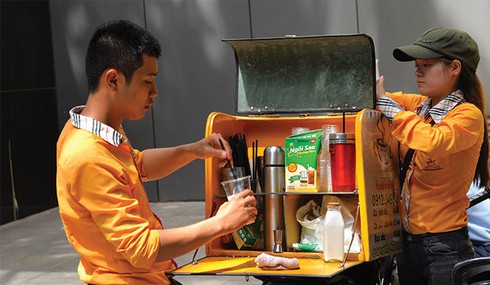Coffee on the run
Mon, 18 Nov 2019 15:45:00 | Print | Email Share:
The way coffee is bought and consumed in Vietnam is changing as new players work hard to get their name out there.

Vietnam’s coffee market has seen the arrival of two newcomers in Ho Chi Minh City in the last two years: Guta Vietnam with small blue shops and mobile trolleys on the street selling coffee and CoffeeBike with orange shops and motorbikes selling coffee.
The two brands have popped up in many corners of the city and won favor among savvy customers and millennials, with both focusing on opening outlets and offering clean coffee, low prices, and takeaway services.
After only a few years, the “coffee-on-the-street” model of the two brands has borne fruit. Guta Vietnam’s revenue is growing about 200 per cent a year, CEO Mr. Nguyen Minh The told VET.
“We expect to retain this growth and expand our brand identity in the next few years.” The chain now has 43 outlets of 10-50 sq m each in the southern city.
CoffeeBike, meanwhile, has 20 motorbike sales points after three years in business. Investment in marketing accounted for about 30 per cent of revenue in the beginning as brand identity in the food and beverage sector is vital.
“Vietnam’s streets are so crowded, while the food and beverage market is growing rapidly,” said local branding expert Mr. Vo Van Quang. “The takeaway market supported by food delivery apps is booming, and vehicle-free pedestrian malls are being expanded. Local consumers want food and drinks to be more convenient to buy. This will drive marketing efforts and brands are opening smaller outlets on the street.”
Highlands Coffee, one of the largest coffee chains in the country and majority-owned by the Philippines-based Jollibee Foods, recently introduced coffee-to-go campaigns to renew its traditional marketing activities. It has also set up coffee stands on certain streets in Ho Chi Minh City and has been successful in the past by seizing upon new trends and optimizing its operations management.
Other coffee brands, like Passio and Vinacafé, have also set up morning coffee stands on some of the city’s busier streets, to gain greater access to the younger segment.
In August, Trung Nguyen Legend also launched its new low-mid segment E-Coffee outlets, which are small-scale coffee shop franchises targeted at takeaway customers. Each will have an area of 4 to 40 sq m and cost between VND65 million and VND175 million ($2,800 and $7,540) to set up. The new franchise model already has 100 outlets nationwide. By the end of this year, the group hopes this number will triple and reach 3,000 around the country by the end of next year. Trung Nguyen Legend used to target mid to high-income customers, but profits were slipping.
Cautious steps
Though the food and beverage market, particularly in coffee, holds major potential and no brand dominates, it’s not easy for foreign brands like NYDC, Burger King, Gloria Jeans & Tea Leaf, and Café Bene to thrive.
The success of a chain model mainly comes from location, which accounts for the majority of operating costs. Large outlets come at a high cost and is why many foreign brands have had to withdraw from Vietnam.
The two newcomers seem to have learned from the problems of their predecessors. CoffeeBike chose the low-end segment, with competitive prices and Espresso as a core product, and its advantage - the motorbike selling model - has low operating costs that create the conditions to grow both its business and brand identity. It also takes advantage of social media to cheaply promote its brand identity, as being a new face has triggered interest among local media.
“The decisive factors for the takeaway model are approach to customers, convenience, quick service, and the customer experience,” Mr. Hoang Tien, CEO of CoffeeBike, told VET . “This last factor, which is the hardest for any brand, will be our focus.” It targets a presence all around the country within the next five years.
Mr. The from Guta said the chain will bring competitive and quality products to the market and create convenience for customers wherever they live or work, so its name will remain top of mind. With 2 per cent spent on marketing, the brand expects to grow 200-300 per cent in the three next years in Ho Chi Minh City, the Mekong Delta, and the southern region.
Optimizing its operational costs and human resources are strengths for Highlands Coffee despite its large scale. Products are designed scientifically and compactly, with both food and drinks being simple in terms of processing and helping with quick customer service. With only a small number of employees, the brand can still cater to many customers, according to CEO and Founder of Pizza Home, Mr. Hoang Tung.
“Highlands Coffee had its own leadership strategy before and during its merger with Jollibee,” he said. “It understands the local market and consumers, selling tasty ‘banh mi’ (bread) together with the best coffee.”
For Trung Nguyen, its E-Coffee outlets are suitable for all locations, including office blocks, metro stations, markets, and convenience stores. Mr. Quang said new and active chains will grow quickly in selling bread and iced coffee for VND33,000 ($1.4). “A combo of products can go very far,” he believes.
Local experts say the country’s coffee market has sufficient space for many new brands to set up shop in the years to come because no one holds a substantial market share as yet. Together with foreign brands in the coffee market will come products such as milk tea, soy drinks, or lemon tea.
By: VN Economic Times/VOV
Source: https://english.vov.vn/economy/coffee-on-the-run-406315.vov
---------------------------------------------
Same category News :













